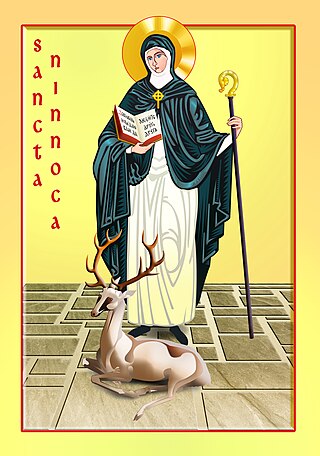Related Research Articles

Gwen Teirbron was a Breton holy woman and wife of Fragan who supposedly lived in the 5th or 6th century. Her epithet is Welsh for '(of the) three breasts'.
Salomon was a late 5th century Cornish 'warrior prince', possibly a King of Cornwall. His feast day takes place on the 18 October. He was the father of the Cornish bishop Saint Cybi.

Saint Cynllo is a British saint, who lived in the late 5th and early 6th centuries, generally described as a brother of Saint Teilo. Cynllo was known for "...the sanctity of his life and the austerity of his manners."

July 4 - Eastern Orthodox Church calendar - July 6

February 1 - Eastern Orthodox liturgical calendar - February 3

Winwaloe was the founder and first abbot of Landévennec Abbey, also known as the Monastery of Winwaloe. It was just south of Brest in Brittany, now part of France.

Dubricius or Dubric was a 6th-century British ecclesiastic venerated as a saint. He was the evangelist of Ergyng and much of south-east Wales.
Juthwara or Jutwara was a virgin and martyr from Dorset. According to her legend, she was an eighth-century Saxon, and sister to Sidwell, though some historians have theorised she was a Briton living in the sixth century. Her relics were translated to Sherborne during the reign of Ethelred the Unready. Nothing further is known with certainty about her life.

October 16 - Eastern Orthodox liturgical calendar - October 18

Ceitho was an abbot and a saint living in West Wales in the 6th century. According to legend he was one of the five sons born to Cynyr Farfdrwch of Cynwyl Gaeo, and a descendant of the ancient Welsh king Cunedda Wledig. Along with his brothers Gwynno, Gwynoro, Celynin, and Gwyn, he became a saint. The five brothers are said to have founded the village of Llanpumsaint in Carmarthenshire.
Cadfan, sometimes Anglicized as Gideon, was the 6th century founder-abbot of Tywyn and Bardsey, both in Gwynedd, Wales. He was said to have received the island of Bardsey from Einion Frenin, king of Llŷn, around 516 and to have served as its abbot until 542.
Mawgan and Meugan are names referring to either one or two Brythonic saints who flourished in the 5th or 6th century. Both names are widely attested in place-names and church dedications, Mawgan in Cornwall and Brittany and Meugan in Wales, but it is uncertain whether the names refer to one and the same person. The parishes of St Mawgan and Mawgan-in-Meneage in Cornwall derive their names from Mauganus. There is also a Machan in West Lothian (Scotland), as shown by the place-name Ecclesmachan, but again this may be a distinct figure.

October 23 - Eastern Orthodox liturgical calendar - October 25
Budic II, formerly known as Budick, was a king of Cornouaille in Brittany in the late 5th and early 6th centuries. He was father of Hoel as well as several Celtic saints.

March 10 - Eastern Orthodox liturgical calendar - March 12
Wethenoc or Gwethenoc or Guethenoc was a 5th-century pre-congregational Breton saint.
Cynyr Ceinfarfog was a ruler of the Kingdom of Dyfed in Wales. He was known as Cunoricus in Latin and in English as Kendrick or as Cynyr the Red.

Saint Ninnoc or Ninnog of Breton, also known as Nenooc, Nennoca, Nennocha, Ninnoc, Ninnocha, and Gwengustle, was an early medieval abbess born in Wales who died in Brittany. The text of Vita Sanctae Ninnocae, preserved in the Cartulary of Quimperlé, provides knowledge of her life and work.

Klervi was a 5th-century pre-Congregational saint from the Welsh settlement of Ploufragan in Armorica, later a part of Brittany and France.
References
- ↑ "Modèle:Almanak octobre". GrandTerrier. Archived from the original on 13 October 2007. Retrieved 11 October 2017.
- 1 2 3 Butler, Alban. The lives of the fathers, martyrs, and other principal saints , volume 1, p. 275 (Henry & Co. 1857).
- 1 2 3 Baring-Gould, Sabine and Fisher, John. The Lives of the British Saints: The Saints of Wales and Cornwall and Such Irish Saints as Have Dedications in Britain , Volume 3, p. 38 (1911).
- ↑ William Hone, The every-day book and table-book; or, Everlasting calendar of popular amusements (William Hone, 1837) p281.
- ↑ Baring-Gould, Sabine and Fisher, John. The Lives of the British Saints: The Saints of Wales and Cornwall and Such Irish Saints as Have Dedications in Britain , Volume 2, p. 9 (C. J. Clark, 1908).
- ↑ Ancien nom parfois attribué au vent, en particulier au mistral, mais ici au vent de noroît
- ↑ Moine Clément, Vie de saint Gwennolé confesseur, dite Vie brève, vers 860
- ↑ "Saint-Frégant : Histoire, Patrimoine, Noblesse (commune du canton de Lesneven)". infobretagne.com. Retrieved 11 October 2017.
- ↑ "Prieuré de Lochrist-an-Izelvet (ou Izelvez) en Plounévez-Lochrist (Finistère - Bretagne)". infobretagne.com. Retrieved 11 October 2017.
- ↑ Albert Le Grand, La vie, gestes, mort et miracles des Saints de la Bretagne Armorique, ensemble un catalogue des évêques des neuf eveschés d'icelle, 1659,